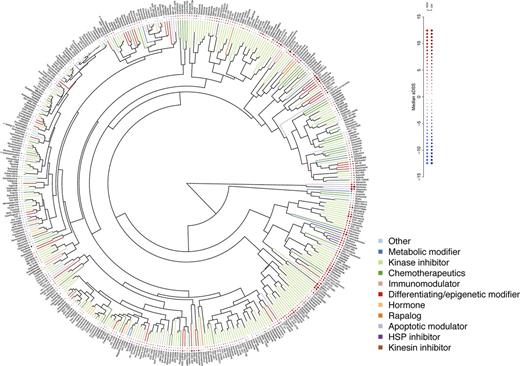Abstract
Introduction
Most patients with acute myeloid leukemia (AML) are still missing effective options for targeted treatments. Here, we applied individualized systems medicine (ISM) concept1 by integrating deep molecular profiles (genomics, transcriptomics) and ex vivo drug response profiles with 521 oncology drugs in 154 AML patient samples. The aim was to identify new treatment opportunities for molecular subsets of AML patients. When feasible, ISM guided treatment opportunities were applied clinically for AML patient treatment. Serial samples were available to identify molecular alterations in response to targeted drug treatment and to monitor therapeutic success or failure. We also aimed at testing the impact of bone marrow stromal cell conditioned media on drug response profiles in AML patients2.
Methods
Samples from bone marrow or blood of 122 AML patients and 17 healthy donors were obtained with written consent and ethical approval (239/13/03/00/2010 and 303/13/03/01/2011) from the Hematology Clinic, Comprehensive Cancer Center, Helsinki University Hospital. The ex vivo drug sensitivity and resistance testing (DSRT) assay was performed with 521 approved oncology drugs and investigational oncology compounds as described earlier1. In this study, freshly isolated mononuclear cells were randomly resuspended either in standard mononuclear cell medium (MCM, PromoCell) or in human bone marrow stroma derived conditioned medium (CM) for drug testing. DNA samples from same mononuclear cells were subjected to whole exome and transcriptome sequencing and data were analyzed as described previsously2. Hierarchical clustering and non-parametric rank correlation were performed with drugs and samples. Wilcoxon sign ranked test was applied between wild type and mutated samples to identify significant mutation-drug associations.
Results
Hierarchical clustering was largely independent of clinical features such as disease status or risk class. A strong drug sub-cluster with a unique response profile was composed of that of the MDM2 antagonist idasanutlin along with BCL-2 inhibitors navitoclax and venetoclax (Figure). BET inhibitors (JQ1, I-BET151, birabresib) and MEK inhibitors (trametinib, selumetinib) were positively correlated with each other suggesting an association between bromodomain mediated epigenetic deregulation and up-regulation of the MEK pathway in a subset of patients. Comparison between patient samples profiled in CM (n=77) vs MCM medium (n=77) indicated higher efficacy of MDM2 modulator idasanutlin in MCM while BET inhibitors responded more strongly in CM. Other differences observed earlier by Karjalainen et al1 between the two media types were also validated. Furthermore, 16 chemorefractory and one diagnostic stage patients were treated with the targeted drugs suggested by this ISM approach. We observed complete remission or leukemia free state in 35% (6/17) of the AML patients given tailored treatment in an observational study. The targeted drugs used for clinical translation included ruxolitinib (in n=4 patients), temsirolimus (n=5), trametinib (n=4), sunitinib (n=7), dasatinib (n=7), sorafeninb (n=4), omacetaxine (n=3) and dexamethasone (n=5).
Summary
This study highlights the potential of individualized systems medicine (ISM) approach in the identification of effective treatment opportunities for individual patients with AML. Identifying molecular markers for ex vivo drug responses can help to assign treatments to the patient subgroups most likely to respond in clinical trials.
Heckman: Orion Pharma: Research Funding; Novartis: Research Funding; IMI2 project HARMONY: Research Funding; Pfizer: Research Funding; Celgene: Research Funding. Porkka: Bristol-Myers Squibb: Honoraria, Research Funding; Novartis: Honoraria, Research Funding; Celgene: Honoraria, Research Funding; Pfizer: Honoraria, Research Funding.
Author notes
Asterisk with author names denotes non-ASH members.


This feature is available to Subscribers Only
Sign In or Create an Account Close Modal